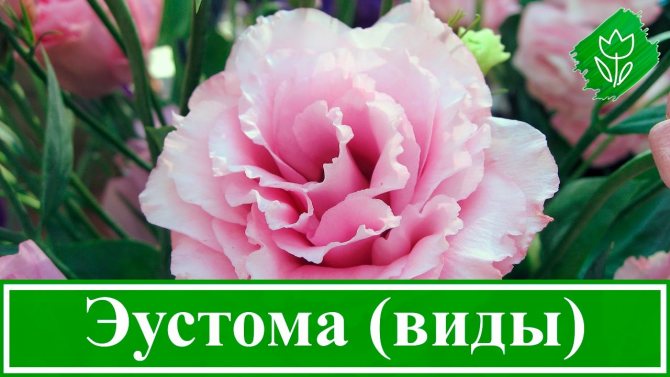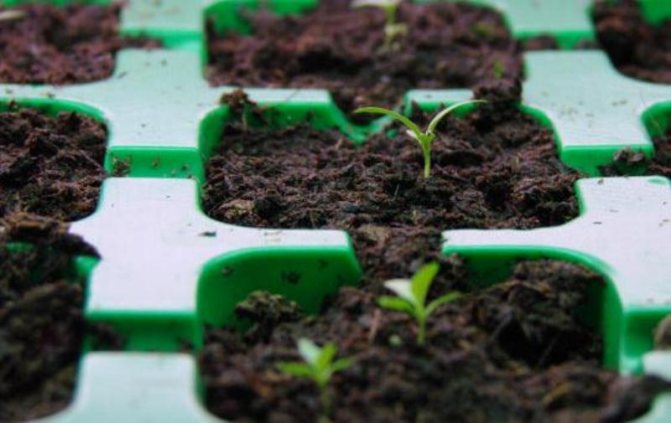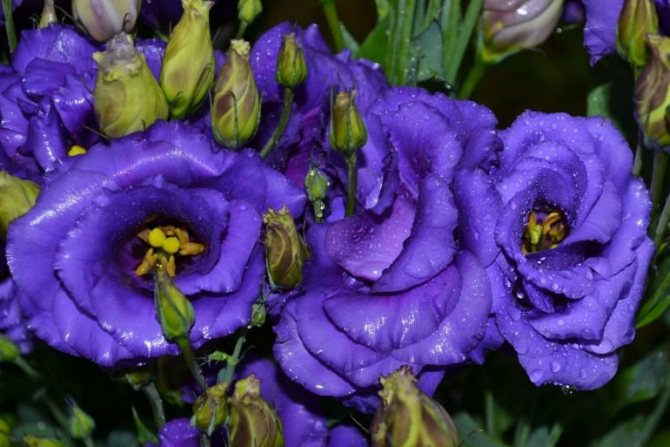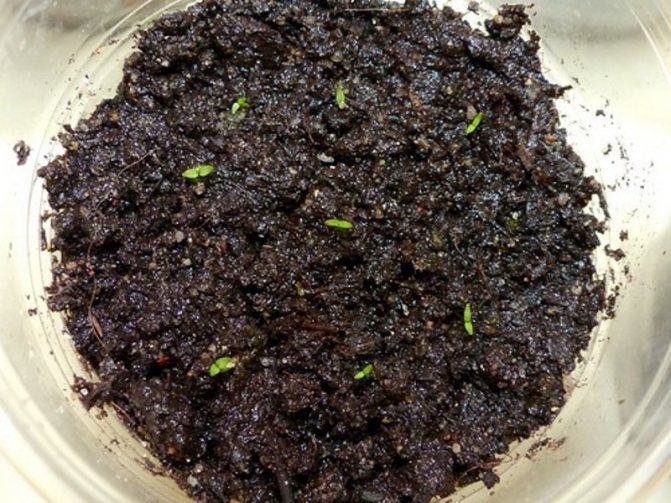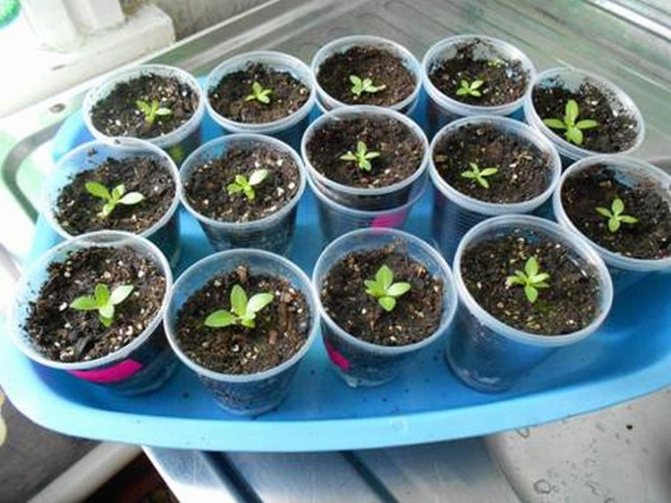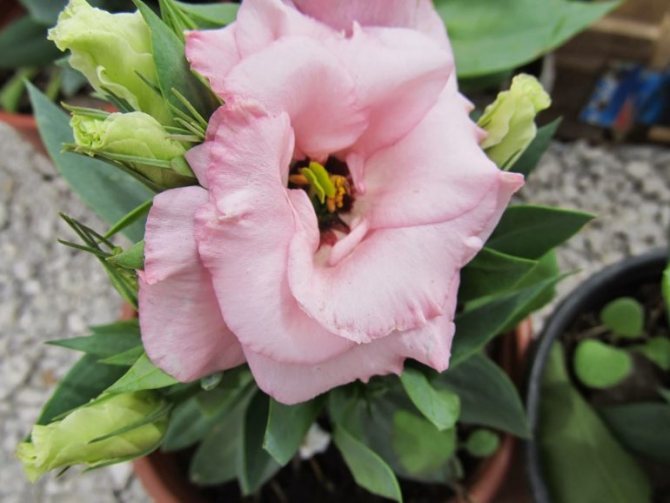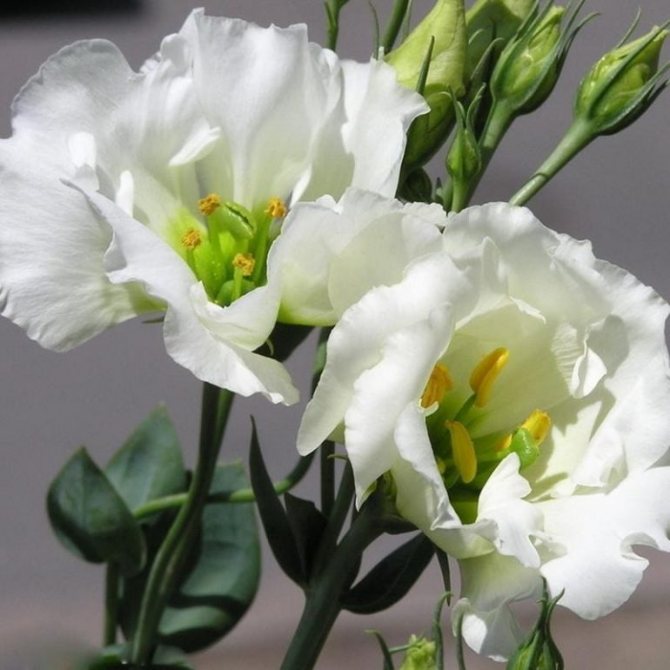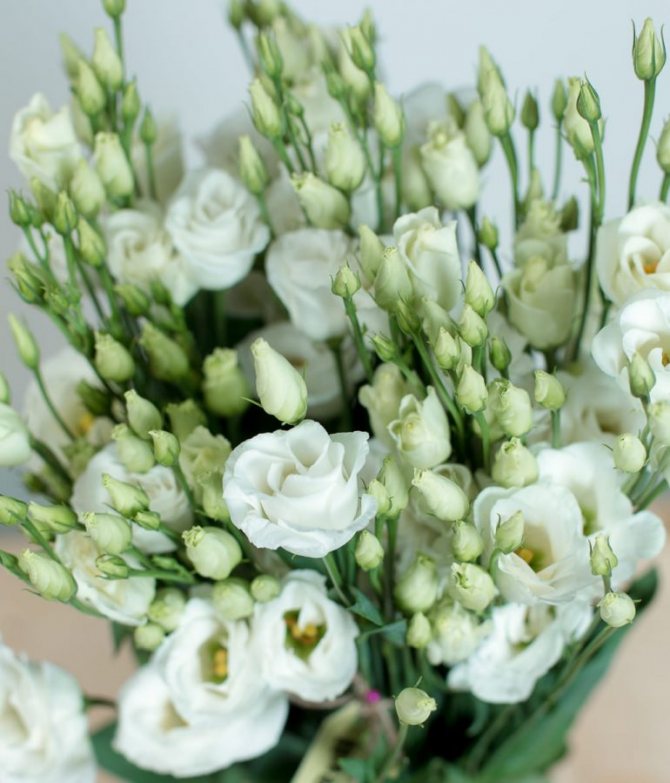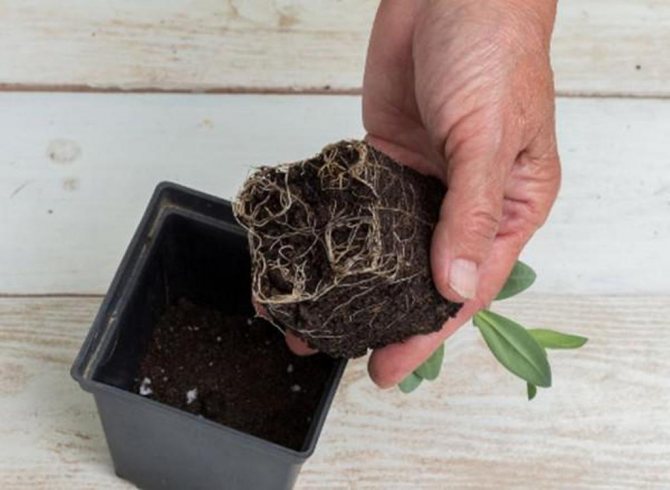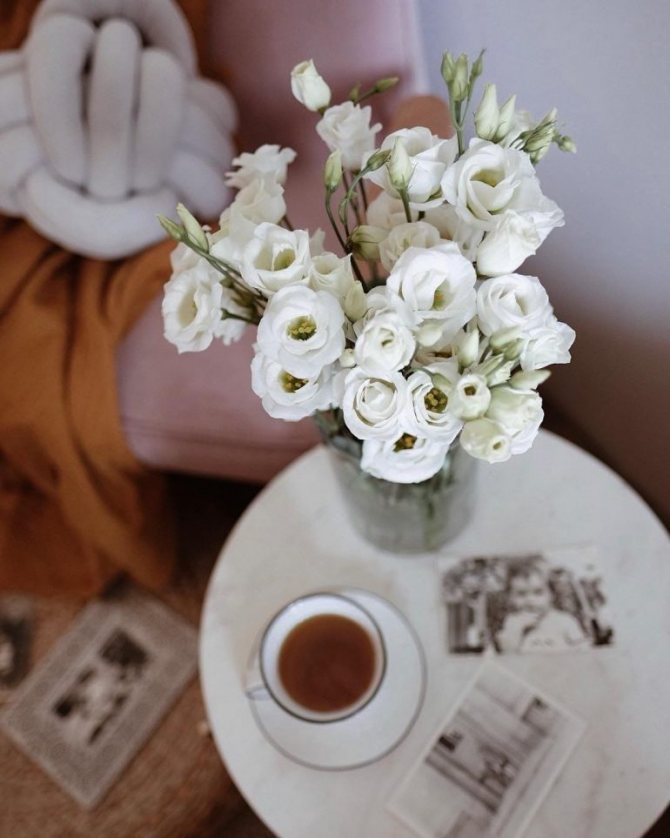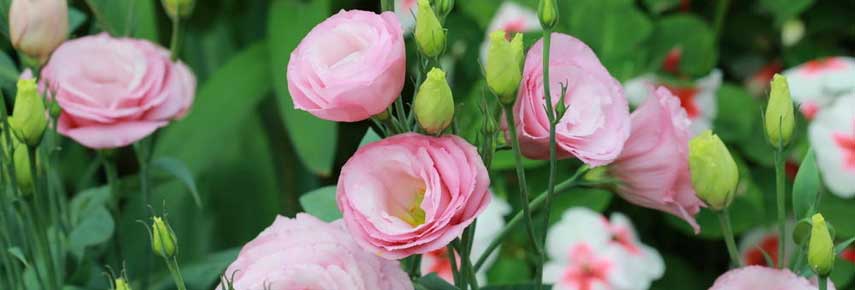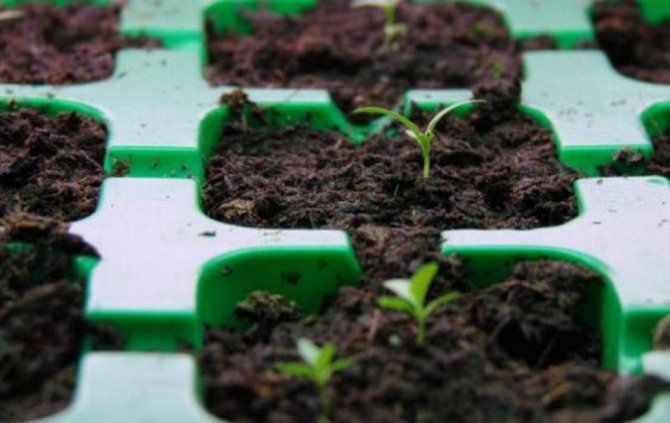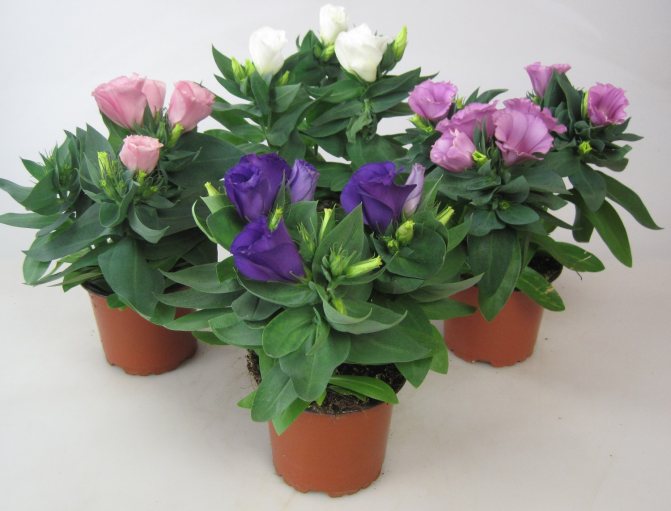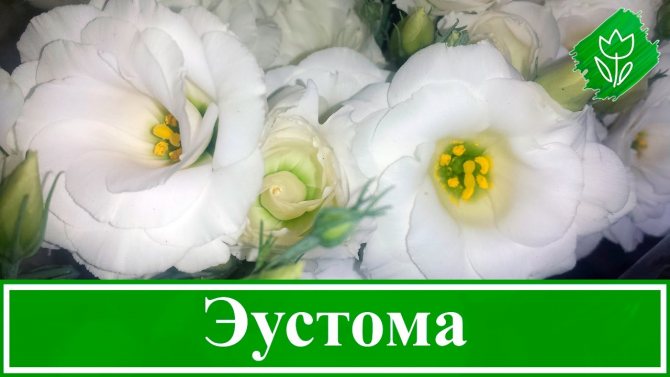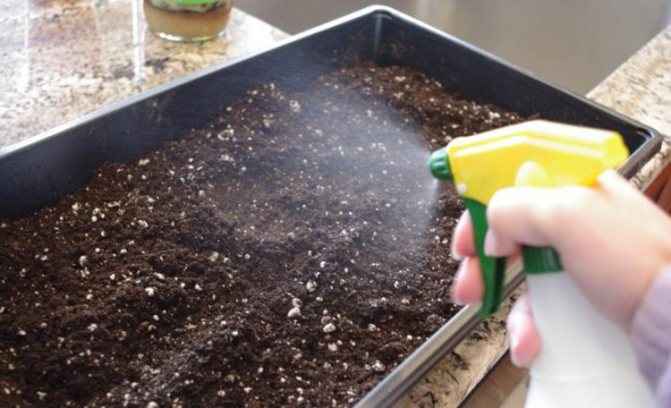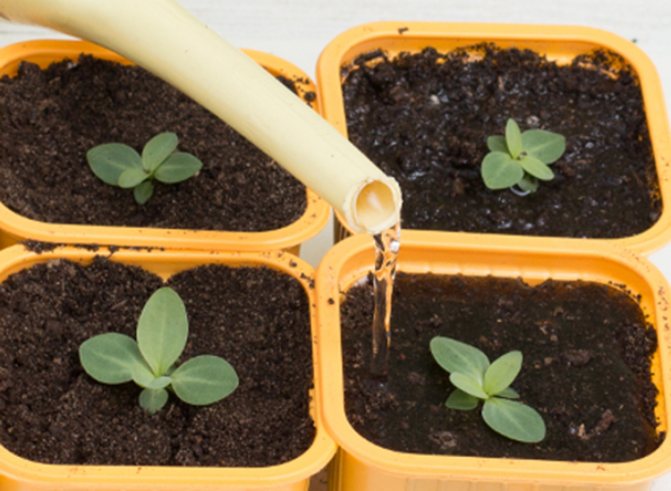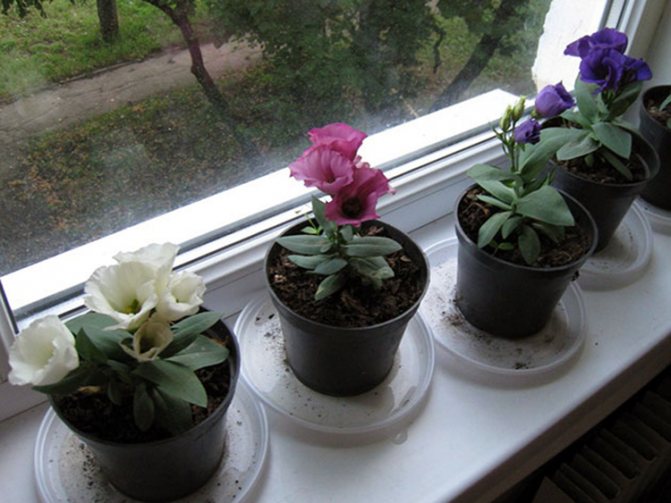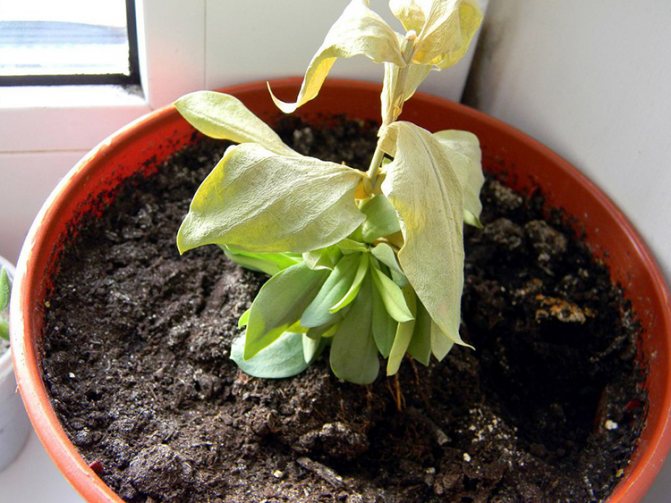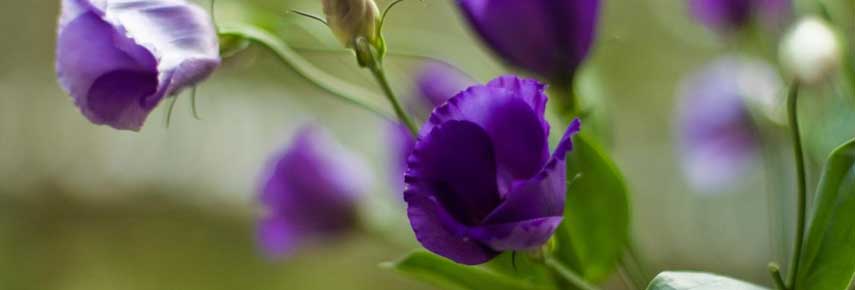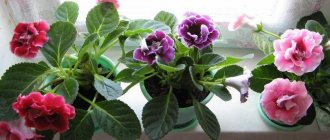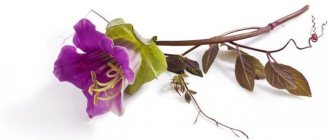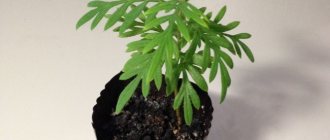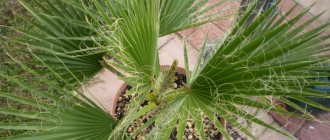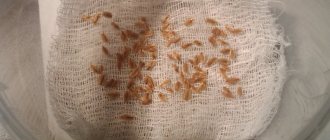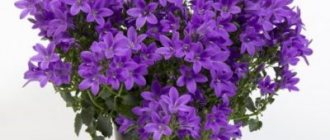Eustoma is gaining more and more popularity among amateur flower growers. If earlier this flower could be found only on the flower beds of "advanced" florists, now it is grown almost everywhere. Or trying to grow, at least. Eustoma may well compete with a common favorite - a rose. Yes, and among the people it bears the names "Irish Rose", "Japanese Rose", but there is also a nickname "Texas Bell". Has eustoma and the second official name - Lisianthus, which in translation into the native language means "bitter flower" (apparently someone tried to eat it).
In nature, eustoma grows in parts of America and the Caribbean. In our country, it is successfully grown both in flower beds and flower beds, and at home, as a houseplant. Cutting eustoma is very good. Here it is a worthy replacement for roses, not only in beauty, but also in terms of the duration of preservation in this state. A bouquet made of eustomas can stand in a vase for three weeks, or even more.
A little about the plant
Eustoma is a fairly tall plant. A whole bunch of three dozen buds can grow on a graceful stem of a meter in height. Eustoma flowers are either double or simple, resembling a poppy in the open state. Their color can be white, lilac, pink, purple. The diameter of the flowers is average, within 5-8 centimeters. Eustoma leaves, green with a gray tint, are also very beautiful, as if molded from wax. As a garden flower, it is grown as an annual, maximum biennial. At home, the eustoma is a perennial plant.
Types of Eustoma and popular varieties
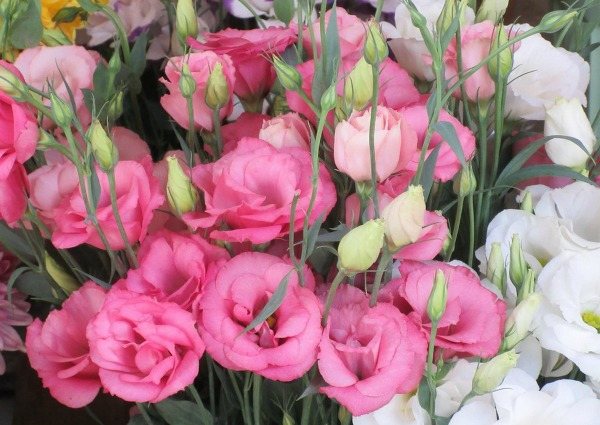
As you know, Eustoma is very diverse. It can be terry and non-terry. Until the flower has blossomed, it is very difficult to distinguish it from rosebuds, and the blossoming Eustoma looks like poppy flowers.
Consider some cut varieties of this plant:
- Eustoma Echo Pink Pikoti F1 is a plant, about 70 cm high. Double flowers, early flowering. The colors can be either one-color or two-color. In the cut form, it remains for a long time.
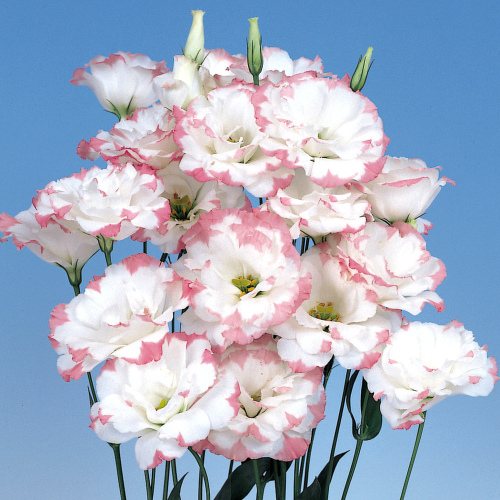

Eustoma Echo Pink Pikoti F1 - Aurora... This species is famous for its variety of colors. It can be white, light blue, blue or pink. Coloring the petals. The plant is more than 130 cm tall. It begins to bloom quite early.
- Mermaid (Mermaid). The species is low-growing, no more than 20 cm high. The bush is very spreading. It blooms in white, blue, pink and purple flowers.
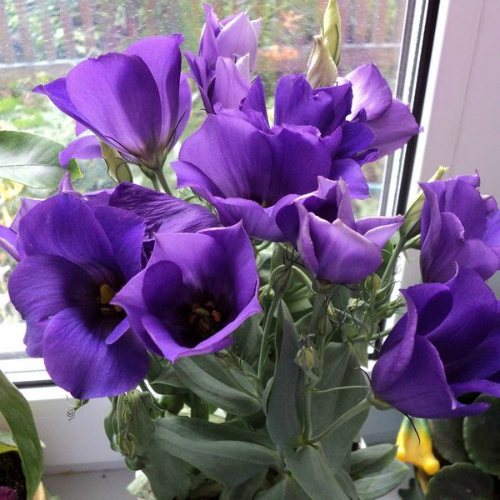

Eustoma the Little Mermaid blue F1 - Flamenco. Tall, reaching 120 cm in height, eustoma, large-flowered, buds grow up to 8 cm. Eustoma has won the hearts of many gardeners. Moreover, this variety is not very whimsical.
- Heidi. This profusely flowering Eustoma of medium height has a stem, flowers are predominantly of a simple type, the color is very diverse, up to 15 different options.
- Little Bell. This is a variety of low-growing Eustoma. The size of the bush is not more than 15 cm. The flowers are mostly simple, medium-sized with a rich range of shades.
Of course, these are not all varieties of this plant. In fact, there are a lot of them.
When to sow Eustoma for seedlings
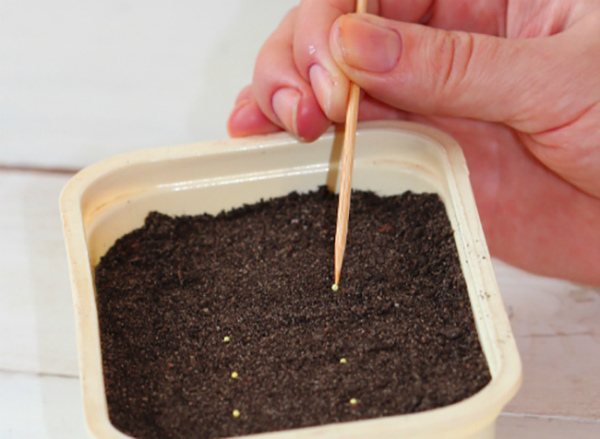

It will be possible to admire the beautiful flowers of Eustoma almost only when it is grown through seedlings.The time from the first shoot-loop to the first beautiful flower takes about six months. It is clear that one cannot do without seedlings. And it is necessary to sow Lisianthus seeds in winter, and sometimes even at the end of autumn.
There are many different opinions on when to sow seeds. Some gardeners say that the end of December and the beginning of January is the best time, other gardeners say that the Eustoma sown in late February and early March will have time to please with beautiful flowers. When sowing seeds, it is necessary to take into account the climatic characteristics of the region of residence and the time required for the growth of seedlings.
If Eustoma is grown as a houseplant, then you need to calculate only the time until the flowers form, and you should not pay attention to the climate.
When to sow eustoma in the regions
- When planning to get gorgeous flowers in Siberia in the middle of summer, you should take care of sowing seeds in the late autumn of the previous year.
- For the middle lane and the Moscow region, you can plant seeds for seedlings a little later in January-February.
- Gardeners of the southern regions can plant Lisianthus in February-March.
When to sow eustoma according to the lunar calendar in 2020
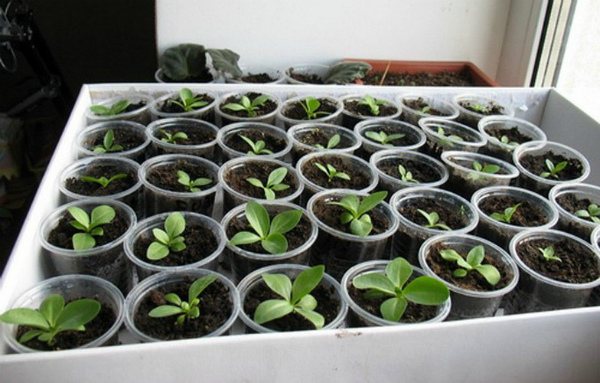

More than 20 weeks pass from germination to flowers, so you need to take care of the sowing in a timely manner and do it better focusing on the lunar calendar.
In the table, you can find out which in 2020 will be the best and worst days.
| Month | Auspicious days | Bad days |
| January | 4-7, 9, 10, 27-29 | 11, 24-26 |
| February | 1, 2, 6, 7, 26-28 | 3, 8, 9, 17, 21-23 |
| March | 1, 2, 4-8, 26, 28, 31 | 9, 19-21, 24, 27 |
How to grow eustoma in the garden
Only transfer plants when the frost risks have completely disappeared. The place should be cozy: no scorching sun rays and drafts. The ground should not have excessive moisture. It is better to water the soil, it is easier to deal with these problems, but it is much more difficult to deal with excessive moisture.
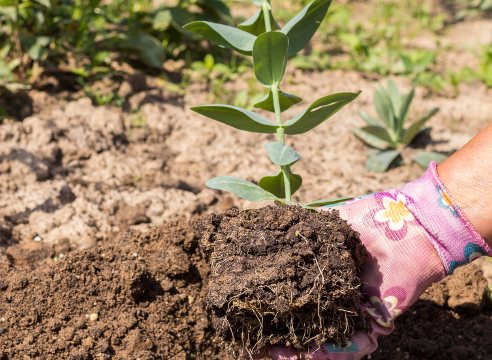

Plant seedlings in holes
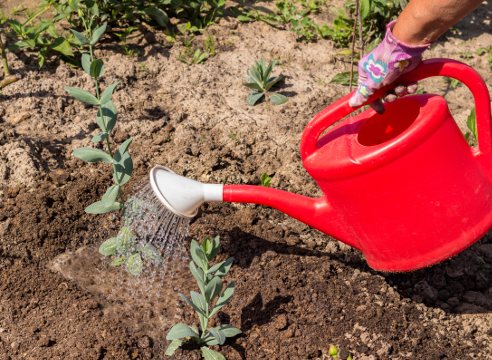

Water the planted seedlings well
It is recommended to cover delicate and weakened plants with cut plastic bottles immediately after planting. During transplantation, in no case tear off a clod of old earth from the roots. Very carefully remove the eustoma from the container, before that, moisten the earth a little. The plant sits in the prepared hole along with a lump of earth. The distance between individual plants is about 15 centimeters. If you have taller varieties, then the distance needs to be increased.


Eustoma mulching
How to grow Eustoma seedlings at home
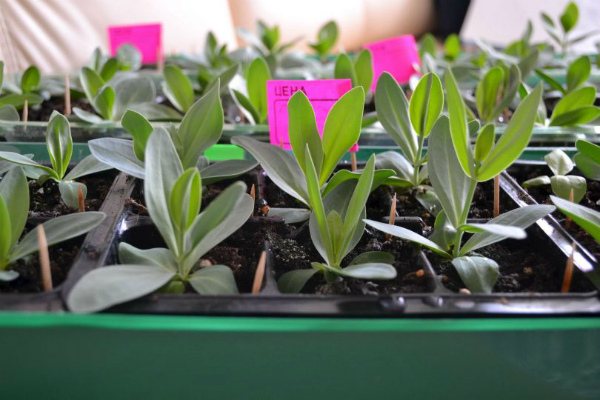

To get such beautiful flowers, you can take care of the seedlings for several months. Before sowing seeds, you need to prepare the soil, containers and the seeds themselves.
Preparation of soil and containers
The soil can be used already prepared by the store, it is best if it is for growing Saintpaulias. It is worth adding a little sifted sand or perlite to it. Or you can cook it yourself based on peat:
- Peat - 6 liters;
- Garden land - 3 liters;
- Sand - 1 liter.
Whichever soil is used, care must be taken that it is light, breathable and not acidic. To avoid acidity, you can put 1-1.5 cups of ash on a bucket of prepared soil.
Disposable containers with a lid that sell cookies and cakes are ideal containers. But you can also buy special mini-greenhouses. These are such containers, often divided into small containers with a transparent lid. And of course peat tablets are just great for growing Eustoma seedlings. They are already filled with useful microelements.
Seed selection and preparation for sowing
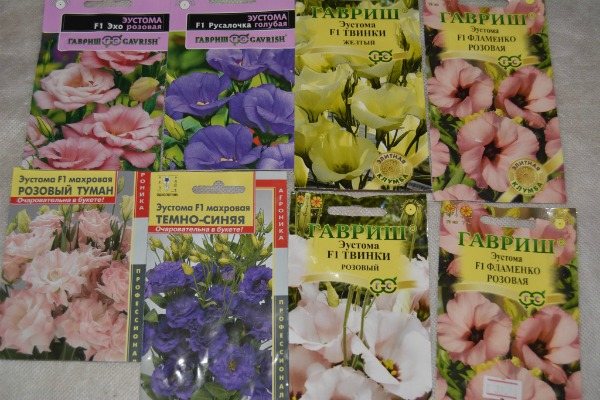

It has been said more than once that Eustoma can reproduce exclusively by seeds. This is where you need to carefully analyze your choice. You need to look at the height, so if it is stated on the package with seeds that their height is 75-95 cm, such an Eustoma is grown in an open-air garden and used for cutting.But plants about half a meter tall can be bred at home.
In Russia, Eustoma is grown as an annual plant, as well as undersized varieties, as an indoor plant.
Everyone can choose a variety according to their preference. The seed market is very wide. You can choose from simple pieces to terry. With petals of various colors.
Sowing Eustoma
You will have to take care of the seedlings of the Irish rose for six months, then you need to take care of additional lighting in a timely manner.
Sowing is best done in peat tablets, the diameter of which is 4 cm.
- First, the tablet is prepared, it must be soaked in a small amount of water. It is correct not to immediately put the tablet in a large volume of water and let it take as much liquid as needed. It is necessary to place them in a container and gradually add warm water, allow to absorb moisture and, if necessary, add more.
- One Lisianthus seed should be placed in the tablet prepared in this way. Eustoma seeds are very small and sometimes do not have enough strength to break through the dragee chamber. Before sowing, you need to help the seed. The dragee is soaked for 20-30 minutes in warm water, and after soaking, the shell is broken with a thin stick.
- All pills with seeds must be placed in a container and covered with a transparent lid or glass sheet.
The container is placed in a warm place, with a daytime temperature of at least 20-25 ° C, and at night the temperature should not be below 15-20 ° C above zero.
In addition to heat, it is necessary to provide landings with additional lighting. The duration of daylight hours should be at least 12 hours. In case of insufficient natural light, the plant must be supplemented with lamps.
Care of eustoma seedlings after germination
Correct sowing of eustoma, the best ways: video
Description of the flower
The legend of the American Indians says that Eustoma first bloomed on the grave of an innocent girl who refused to reciprocate to the God of War and was killed by him for this. For Europeans, this wonderful flower was discovered by the Irish physician and botanist Patrick Brown.
Under natural conditions, it is a biennial herb with an erect stem up to 60 cm high. The leaves are large, whole, greenish with a bluish tinge. Flowers are bright, blue, solitary. Eustoma cultivars appeared relatively recently.
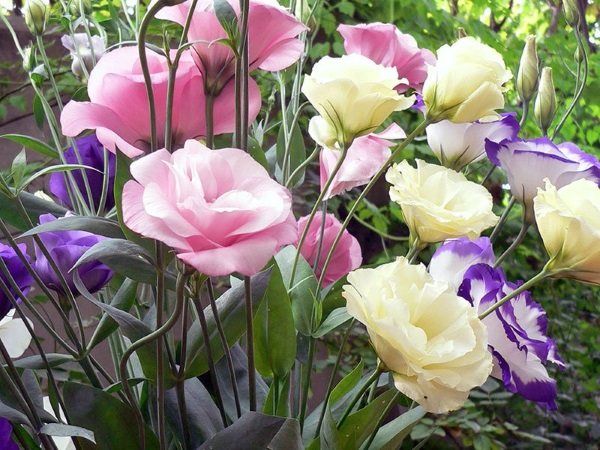

They, unlike wild species, have flowers of different colors. This is the merit of numerous breeders.
There were varieties with a two-tone color, with double flowers. New varieties are actively developed by breeders in Japan and the United States. Their eustomas no longer look like blue bells from the wild prairie. The appearance of the bush and its flowers, of extraordinary beauty and grace, conquer the hearts of flower growers. A tall, stable stem, similar to the stems of another flower - a carnation, has a graceful shape and is strewn with green leaves with a bluish tint, with a slight waxy coating on them. Somewhere, from the middle of the length of the bush, the stem begins to branch out. During flowering, each bush gains from 30 to 35 buds and looks like an unusually beautiful bouquet.
Structure
With its appearance, lisianthus, like any plant, seems to suggest what conditions it needs in order for it to please with lush flowering. Therefore, the study of the secrets of flower reproduction, the diversity of species and varieties should begin with a step-by-step study of its botanical description, gradually moving on to the issues of breeding and agricultural technology.
Ground parts
In nature, the blue eustoma flower really resembles a bell, which has single flowers, with large blue petals, irregular oval shape, narrowed at the base (sepal). Cultivars and hybrids bred on its basis have a variety of colors: many shades of pink, white, purple, salad and yellow, as well as varieties with a two-color pattern on the petals.Both natural species and garden plants form 15-20 buds on the stem, which bloom alternately. The diameter of the flowers, depending on the variety, is 5-8 cm.
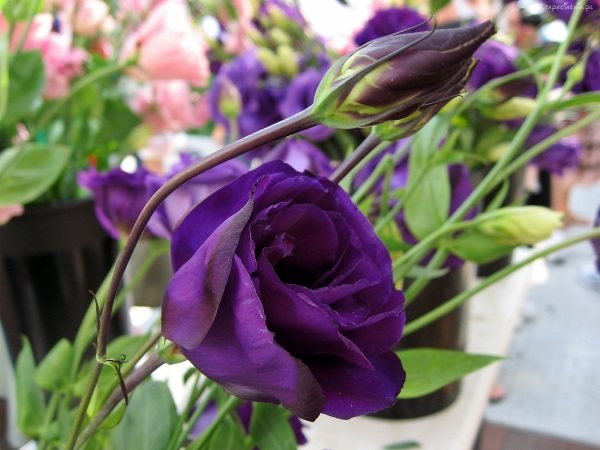

Stem - herbaceous, up to 60 cm high, green, with a bluish tinge, erect, thin. Selection varieties have different stem lengths: short, up to 30 cm - for potted crops, high, reaching 60 - 80 cm - for greenhouse cultivation and cutting. The stems of the herbaceous plant are single, but in the middle of them peduncles are formed on long petioles, which gives the impression that the flower has the shape of a bush.
The leaves are narrow, elongated, without petioles, like a carnation, up to 8 cm from the base to pointed tips. A light waxy coating on the leaves gives the flowers not only an additional decorative look, but also performs additional, protective functions. The bluish tint on the green parts of the plant indicates that in the recent evolutionary past, the eustoma grew in the harsh conditions of the prairies, and the protective waxy shell of the leaves was necessary for the flower to save moisture and escape the scorching sunlight. The narrow and elongated shape of the leaves indicates an economical consumption of moisture.
Root system
Since the flower came to the territory of Europe and Asia, where it is propagated in greenhouse conditions, not so much time has passed - some four hundred years. During this time, breeders have developed a variety of shades and shapes of petals, improving the decorative qualities and leaving the main genetic traits unchanged.
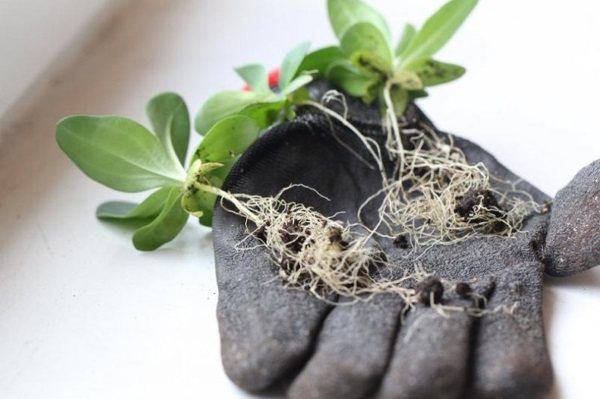

Florists wishing to plant Lisianthus should pay attention to the structure of the root system. Thin, fibrous, highly branched roots grow in the upper layers of the soil without forming strong rods. From these structural features, the following conclusions should be drawn:
eustoma does not reproduce by dividing the bush. Thin fibrous roots of an adult plant die at the slightest mechanical damage, without having time to "recover" and gain a foothold in the soil. For the same reason, eustoma requires extremely careful handling when planting seedlings.
Seeds
There will be no shortage of seeds when growing eustoma. One ripe box contains up to 15,000 small black grains. True, in view of the size of the seed material, growing eustoma from seeds at home is a difficult process.
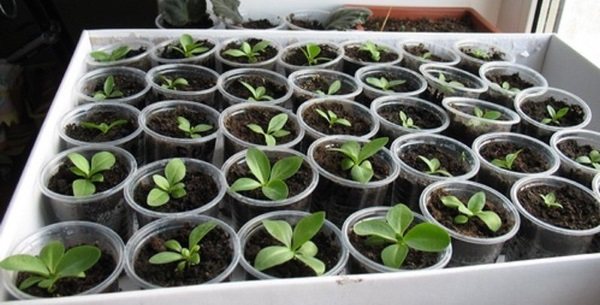

To get eustoma seeds, choose the largest and most beautiful flower that blooms first, wait for it to bloom. In its place, a box will appear, similar to a poppy pericarp. Leave the seed on the stem, taking care to hold it for as long as possible to allow the seeds to ripen. Cut the dried box over a saucer and gently shake out the seeds. For beginner gardeners, it is better to purchase pelleted seeds.
To grow eustoma from seeds, be patient, at least six months. Although the seedlings appear quite quickly, but after that they seem to freeze in thought: to grow or not to grow? In total, the growing season of eustoma of garden and greenhouse varieties lasts six months. Eustoma from seeds grown in a pot under room conditions, under certain conditions, can bloom again after a year.
But about all the conditions and secrets - in order, with step-by-step instructions for planting and care.
Seedling care
The first shoots should be expected in about 7-10 days. They will be as thin as strings. In this state, Eustoma is very vulnerable, even a small drop of condensation can destroy a delicate sprout. Therefore, the mini-greenhouse must be ventilated and the condensate removed.
When the tablets dry (they settle slightly), you need to pour a little water into the container. Excess must be drained, the medium should not be very moist to avoid black leg disease.
Around March, the seedlings will no longer need to be supplemented, she will have enough daylight hours. It is also necessary to harden the plant by this period so that it can already do well without shelter.
This obstinate beauty does not like strong drafts and water shortages. Irrigation generally needs to be carefully regulated. She does not like waterlogging and does not like little moisture either. In the first case, there will be only foliage, with a shortage of water, it will drop the buds.
Picking
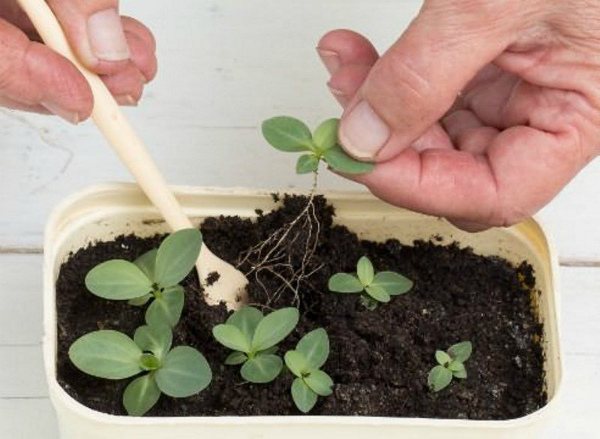

When 2-3 pairs of true leaves are formed, the seedlings must be placed in individual containers. To do this, you need to remove the protective mesh from the tablet, and place the peat lump itself in a container or a larger pot and sprinkle it with soil. The diameter of the container needs to be selected about 7 cm.
For tall plants, it will be necessary to transplant into large pots again (this operation is called “transhipment”). Low varieties that will be grown in hanging pots or in balcony pots at this time can be planted in a permanent place. The transshipment should be carried out in the third decade of March.
In the ground during transshipment, it will be necessary to add 3 tbsp. l. mineral fertilizer:
- Azofoska;
- Nitrofoska.
The soil mixture with fertilizer must be thoroughly mixed. Eustoma does not really like the increased concentration of fertilizer.
When transplanting, you need to pay attention to the root collar. It should be above the soil level.
To avoid stagnation of water, drainage must be poured at the bottom of the container. When watering, do not get water on the leaves. Eustoma is very demanding for watering, this must be remembered throughout the entire growing time.
When to transplant outdoors
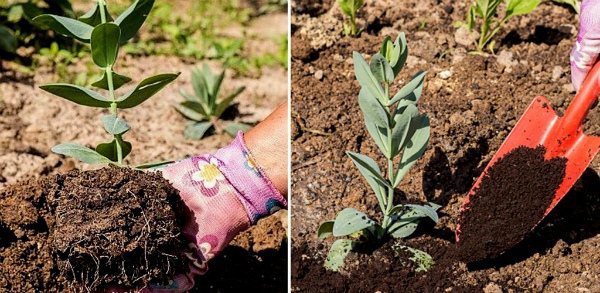

Eustoma goes to a permanent place when the threat of return frosts has passed. This is a different time in each climatic zone, but roughly mid-late May.
The place should be well lit with diffused light.
The soil should be with good moisture and air permeability. Stagnant water is detrimental to Eustoma.
Not bad Eustoma will grow on a sand-peat mixture. Due to the presence of peat, the environment will be acidic, so ash or lime must be added to the soil.
It is necessary to plant seedlings in the evening or in sunless weather.
You need to prepare the hole a little larger than the container in which the seedlings grew. You need to put a little drainage on the bottom of the hole, then add soil, moisten everything well and plant a seedling. The gap between Lisianthus bushes should be at least 15-20cm.
The planted seedlings must be kept under trimmed five-liter plastic bottles for a month. After a couple of weeks, in the daytime, the cap on the bottle must be unscrewed, so the flower will get used to the ambient temperature. During the rooting of seedlings, watering can be omitted, it will have enough moisture from the hole. Eustoma is harmful to both waterlogging and moisture deficiency.
When 6-8 true leaves are formed, the seedling must be pinched so that the bush branches better. 3-4 weeks after planting seedlings in open ground, it must be fed. Plantafol is best suited for this purpose. The first time you need to treat the plant with Plantafol with nitrogen, and the second time about another three to four weeks, Plantafol budding. Of course, you can also use Kemira. The concentration of drugs should be weaker than the instructions.
Prevention of diseases of eustoma seedlings
Coconut substrate and plant fibers are prone to mold growth. Therefore, before using it, it is necessary to carry out treatment with potassium permanganate or fungicide.
When germinating seeds, be sure to ventilate to avoid mold:
- For the prevention of blackleg and fusarium rot, Fundazol is used.
- Recently, many flower growers have fallen in love with epin and zircon. These drugs stimulate physiological processes in the plant organism, increase stress resistance.
Seedling picking
- When four normal leaves appear, the plant is ready for picking.Seedlings grown in a container or peat tablets must be sorted into separate pots, sometimes two, three plants in one container are allowed.
- This procedure will accelerate the growth of the flower, make the plant stronger, and improve the development of the root system.
- With a thin object, gently pry off the miniature plant and remove it from the peat soil.
- A small depression is made in the pot where the pick will be made. The sprout is transferred to this depression.
- The soil must be well moistened. Deepening is carried out along the lower leaves.
- Immediately after the procedure, put on a protective cap (plastic bag or plastic cup). The plants are kept in this state for several weeks.
- As a rule, plants tolerate picking well. In two weeks, your seedlings will be twice as large.
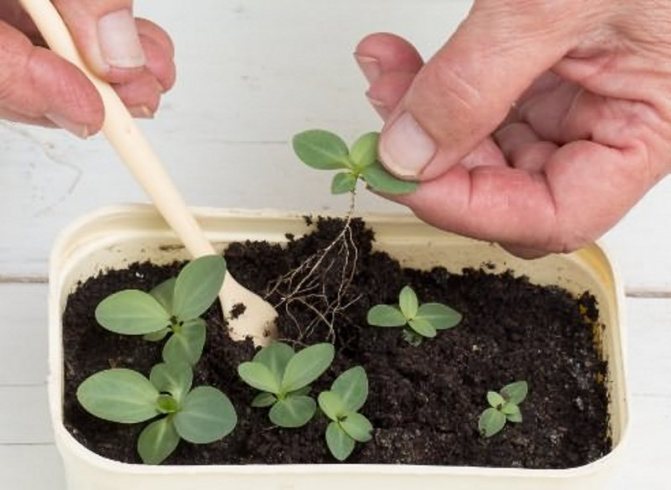

Picking seedlings at the age of 2 months.
Problems of growing eustoma
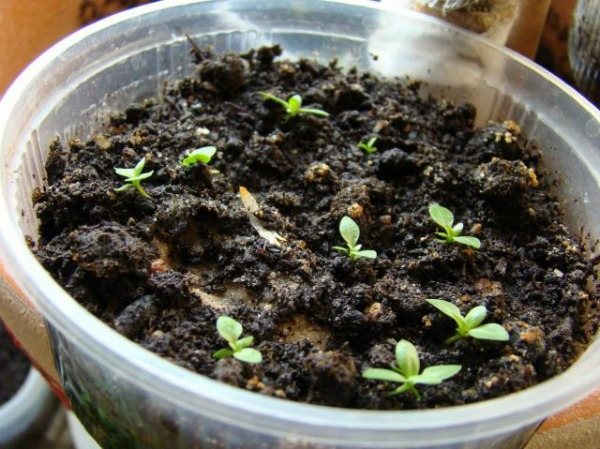

If you follow all the technology of planting and growing Eustoma, there should be no difficulties. If one or another rule is violated, diseases may appear. Such as the:
- Powdery mildew;
- Gray rot;
- Fusarium wilting.
Powdery mildew is recognizable by the white bloom on the leaves of the plant. This disease appears if the seedlings are poorly looked after. To overmoisten the plant, do not observe the heat and light conditions. During the measures taken, the plant will help to cope with the disease. It is necessary to treat the disease with "Saprol" or "Topsin".
For the prevention of parasites such as:
- Slugs;
- Mushroom mosquitoes;
- Miners;
- Whitefly;
- Aphid.
The following drugs are used:
- Fitoverm;
- Mospilan;
- Confidor.
With a disease with fungi, Eustoma will become soft, and will slowly fade.
Disease "Botrytis" will manifest itself with gray spots on the leaves. It appears due to a lack of lighting. The plant will not die, but flowers cannot be expected from it.
Florist tips
- Eustoma grows well in soil, in which there is humus from the bark and low peat.
- Eustoma does not like excessive moisture, and drought too. The best time for watering is when the soil on top dries up by two centimeters.
- This flower does not like direct sunlight. She likes diffused light.
- At home, Eustoma grows better in a place with a lower temperature and good ventilation. If such conditions are provided to her, this beauty will decorate the room for a long time.
- Eustoma should be watered only with settled or boiled water.
- Irish rose also does not tolerate strong waterlogging.
- Eustoma does not like acidic soils, so for cultivation it is necessary to use a mixture of soil with sand.
Temperature and rest period
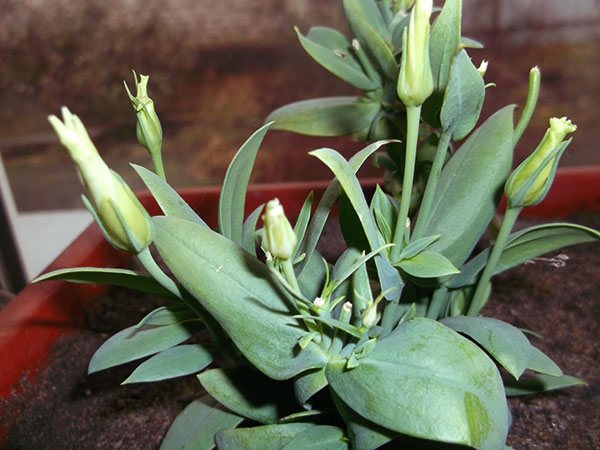

Growing and caring for room eustoma includes maintaining the correct temperature values. This gentle southerner loves soft conditions. The optimum temperature for keeping is from + 20 to + 24 ° C. At such rates, new buds will be laid every year. If the marks reach + 27 - 30 °, then in the first year the bud will first gain nutrients, and will bloom only in the second year. After budding, eustoma needs a rest period.
During this period, plant care has its own characteristics:

